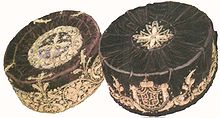| Revision as of 11:10, 1 June 2007 editPaulcicero (talk | contribs)1,005 edits rv, discuss if you have a problem with the article← Previous edit | Revision as of 12:19, 1 June 2007 edit undoCritikal1 (talk | contribs)Extended confirmed users1,192 edits Undid revision 135063210 by Paulcicero (talk) I give an unbiased source, discuss if you have a problem with factNext edit → | ||
| Line 1: | Line 1: | ||
| ] | ]{{clearright}} | ||
| {{clearright}} | |||
| ] | ] | ||
| ] (right) and Queen Milena]] | ] (right) and Queen Milena]] | ||
| The '''Montenegrin cap''' (]: Црногорска капа or ''Crnogorska kapa'') is a ] ]ally worn by ]. | The '''Montenegrin cap''' (]: Црногорска капа or ''Crnogorska kapa'') is a ] ]ally worn by the ethnic ]. | ||
| The cap is in the shape of a flat ], having a red upper surface (called ''tepelak'') surrounded by a ] rim (called ''derevija''). One part of the ''tepelak'' is surrounded with five golden threads, with the center of the surrounded surface being adorned |
The cap is in the shape of a flat ], having a red upper surface (called ''tepelak'') surrounded by a ] rim (called ''derevija''). One part of the ''tepelak'' is surrounded with five golden threads, with the center of the surrounded surface being adorned originally with a six-pointed star, though there are other variations: the wearer's ], initials of the wearer's region (]), a ruler's initials (today often Н. I, the initials of the last Montenegrin king ]), the ] or even the ]. The last two can fill the entire ''tepelak'', in which case there are no surrounding threads. | ||
| After the 1919 ] in Montenegro, the Serbian government started forcing the ] to place the Serbian Cross on their Caps, and banned the Montenegrin Coat of Arms. | |||
| ⚫ | The Montenegrin cap is somewhat similar to the ]; also, similarity is noted to the hat which was traditionally worn in ]. Its final design, which survives until today, was done by the famous Montenegrin ruler and poet ] , who also ascribed ] to it: the red color of the ''tepelak'' symbolises the ] of people who have fallen for freedom |
||
| ⚫ | The Montenegrin cap is somewhat similar to the ]; also, similarity is noted to the hat which was traditionally worn in ]. Its final design, which survives until today, was done by the famous Montenegrin ruler and poet ] , who also ascribed ] to it: the red color of the ''tepelak'' symbolises the ] of people who have fallen for freedom, the black symbolises sorrow for lost freedom, and five golden threads symbolise the five centuries battling the ]. *Note that this symbolism is opinionative and the meaning varies between wearer. | ||
| Through history, it was called by different names: ''valjana'', ''bijela'', ''kariklija'', ''zavratka''. Today it is called simply "montenegrin cap" (''crnogorska kapa''). | Through history, it was called by different names: ''valjana'', ''bijela'', ''kariklija'', ''zavratka''. Today it is called simply "montenegrin cap" (''crnogorska kapa''). | ||
| Line 15: | Line 18: | ||
| * ] | * ] | ||
| ==External Links== | |||
| * | |||
| ] | |||
| ] | ] | ||
| ] | ] | ||
Revision as of 12:19, 1 June 2007



The Montenegrin cap (Serbian: Црногорска капа or Crnogorska kapa) is a cap traditionally worn by the ethnic Montenegrins.
The cap is in the shape of a flat cylinder, having a red upper surface (called tepelak) surrounded by a black rim (called derevija). One part of the tepelak is surrounded with five golden threads, with the center of the surrounded surface being adorned originally with a six-pointed star, though there are other variations: the wearer's initials, initials of the wearer's region (nahija), a ruler's initials (today often Н. I, the initials of the last Montenegrin king Nikola I), the coat of arms of Montenegro or even the of SFRY. The last two can fill the entire tepelak, in which case there are no surrounding threads.
After the 1919 Christmas Uprising in Montenegro, the Serbian government started forcing the Montenegrins to place the Serbian Cross on their Caps, and banned the Montenegrin Coat of Arms.
The Montenegrin cap is somewhat similar to the Lika cap; also, similarity is noted to the hat which was traditionally worn in Risan. Its final design, which survives until today, was done by the famous Montenegrin ruler and poet Petar II Petrovic Njegos , who also ascribed symbolism to it: the red color of the tepelak symbolises the blood of people who have fallen for freedom, the black symbolises sorrow for lost freedom, and five golden threads symbolise the five centuries battling the Ottoman Empire. *Note that this symbolism is opinionative and the meaning varies between wearer.
Through history, it was called by different names: valjana, bijela, kariklija, zavratka. Today it is called simply "montenegrin cap" (crnogorska kapa).